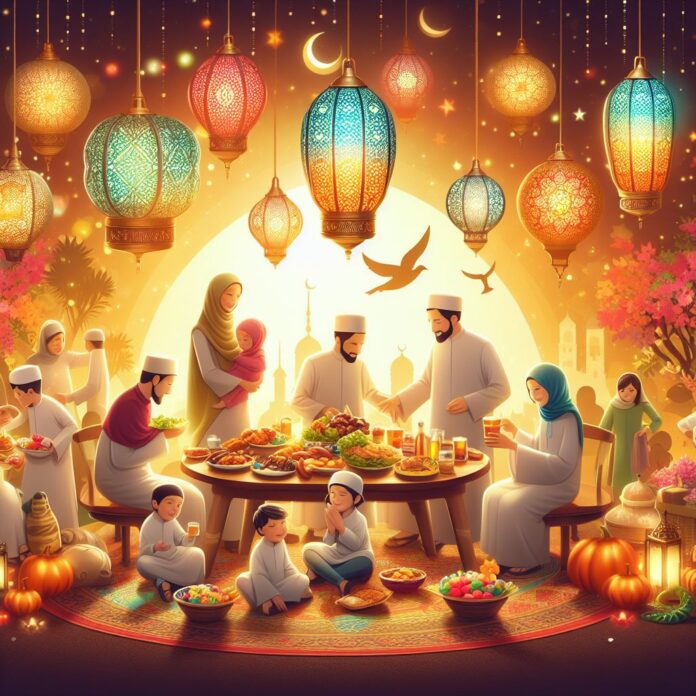Discover the significance of Eid al-Fitr, a festive Islamic holiday marking the end of Ramadan fasting. Explore its customs, rituals, and joyous celebrations worldwide.
Eid al-Fitr, also known as the Festival of Breaking the Fast, is one of the most significant Islamic holidays celebrated worldwide. It is the conclusion of Ramadan, the holy month of fasting that Muslims around the world observe. This joyous occasion is filled with meaningful traditions and festivities that bring families and communities together in celebration.
Table of Contents
Meaning of Eid al-Fitr
“Eid al-Fitr” translates to “Festival of Breaking the Fast” in English. It symbolizes the conclusion of Ramadan, a month-long period of fasting, prayer, reflection, and community. Eid ul-Fitr is a time for Muslims to express gratitude for Allah’s strength and guidance during Ramadan
Traditions and Customs
Eid al-Fitr is celebrated with various traditions and customs that vary depending on cultural influences and regional practices. However unrepealable rituals are widely observed by Muslims worldwide.
Also Read: Eid ul Fitr 2024 – A Joyous Muslim Festivity
1. Eid Prayer:
On the morning of Eid ul-Fitr Muslims gather in mosques or unshut fields to perform the special Eid prayer, known as Salat al-Eid. This prayer consists of two units and is followed by a sermon delivered by the Imam
2. Charitable Giving:
One of the central aspects of Eid ul-Fitr is the practice of Zakat al-Fitr or the “charity of breaking the fast.” Muslims are required to give a specific amount of charity to the less fortunate before the Eid prayer. This act of giving ensures that everyone can participate in the festivities and experience the joy of Eid.
3. Feasting and Hospitality:
Eid al-Fitr is a time for feasting and sharing meals with family, friends, and neighbors. Special dishes and sweets are prepared to mark the occasion, and it is customary to invite guests into one’s home to partake in the festivities.
4. Exchanging Gifts:
Gift-giving is another cherished tradition during Eid al-Fitr. Families exchange presents, especially with children, to express love and affection for one another.
5. Wearing New Clothes:
It is customary for Muslims to wear new or their best clothes on Eid ul-Fitr as a symbol of renewal and prosperity. This practice adds to the festive atmosphere and enhances the sense of joy and celebration
Celebrations Around the World
Eid al-Fitr is celebrated with great enthusiasm and fervor in Muslim-majority countries and communities worldwide. Every area has distinct cultural practices and customs that add to the celebration’s richness. From bustling markets and vibrant street decorations to communal prayers and family gatherings, Eid ul-Fitr is a time of unity, compassion, and joy for Muslims everywhere.
Conclusion
Eid al-Fitr is a joyous occasion that holds deep spiritual significance for Muslims worldwide. It represents the culmination of a month-long period of fasting, prayer, and reflection, and serves as a time for gratitude, generosity, and community. Through its rich traditions and customs, Eid ul-Fitr brings people together in celebration and reinforces the values of compassion, kindness, and solidarity.
.
FAQs (Frequently Asked Questions)
1. What is the significance of Eid al-Fitr?
Eid al-Fitr marks the end of Ramadan, the holy month of fasting, and is a time for Muslims to celebrate the completion of this spiritual journey.
2. How long does Eid al-Fitr last?
Eid al-Fitr typically lasts for one to three days, depending on cultural and regional differences.
3. What are some traditional foods eaten during Eid al-Fitr?
Traditional foods vary by region, but some common dishes include biryani, samosas, kebabs, and sweet treats like baklava and sheer khurma.
4. Can non-Muslims participate in Eid al-Fitr celebrations?
Yes, non-Muslims are often welcome to join in Eid ul-Fitr celebrations as a gesture of inclusivity and community harmony.
5. What is the difference between Eid al-Fitr and Eid al-Adha?
Eid ul-Fitr celebrates the end of Ramadan, while Eid al-Adha commemorates the willingness of Ibrahim (Abraham) to sacrifice his son as an act of obedience to God.







